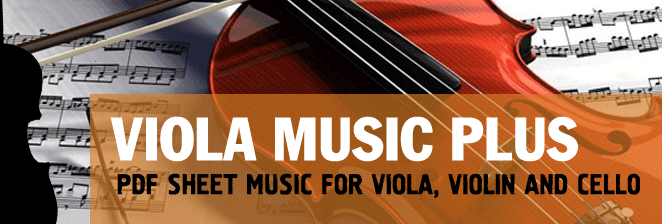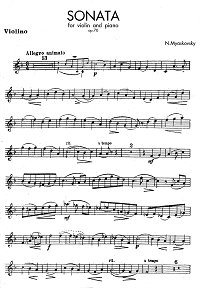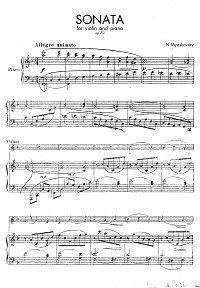|
|
 |
|
| |
| |
Myaskovsky - Violin sonata
Myaskovsky - Violin sonata. You can download the PDF sheet music Myaskovsky - Violin sonata on this page. Miaskovsky composed complex, somewhat modernistic scores that have been described as troubled landscapes overcast with a pall of oppressive gloom. Russian critics of the time likened him to Tchaikovsky and Dostoyevsky as a traveller in the realm of mental darkness. Nevertheless, much of his music, as this violin sonata nad other, throughout his life expresses a deep sadness, and the often cited move toward simplification after 1917 simply is not borne out by the scores themselves.
In Russian music Miaskovsky represents stability more than innovation, despite his progressive associations up through the 1920s. His own modernism is more an evolution from the past than a break with it.
To download PDF, click the "Download PDF" button below the appropriate sheet music image.
To view the first page of Myaskovsky - Violin sonata click the music sheet image. |
| PDF format sheet music |
|
|
|
Instrument part: 20 pages. 26520 K
|
Piano part: 48 pages. 84125 K
|
 |
 |
|
|
| Download PDF (14.99
€) |
Download PDF (14.99
€) |
|
Nikolai Yakovlevich Miaskovsky was born on 20 April 1881 in Novogeorgiyevsk near Warsaw. His father, an army engineer and later general, was determined that his son should pursue a similar career, although the young Nikolai detested the military and showed an intense love of music from an early age. After their mother's death in 1890, the five Miaskovsky children were brought up by an aunt who had sung in the chorus of the Mariinsky Theater in St. Petersburg. She encouraged Nikolai in music, but her religious mania may have contributed to his pessimism and withdrawal. At the age of twelve he was enrolled'in the first of a series of military schools, but three years later he vowed to make music his life's work. The decisive event was a concert in St. Petersburg at which Nikisch conducted the Pathétique Symphony. Thereafter a copy of Tchaikovsky's score became Miaskovsky inseparable companion and a powerful influence on his developing musical consciousness.
Though music was of necessity a sideline during the period of his military education, Miaskovsky pursued itto the extent possible, obtaining some private instruction first from Glière in Moscow and then from Ivan Kryzhanovsky in St. Petersburg. The latter is known for his progressive tendencies; much later he came under attack for "infecting" Miaskovsky with "modernism" and "formalism". In the spring of 1907, as soon as Miaskovsky was free to resign from the military, he entered St. Petersburg Conservatory as a full-time student of Liadov and Rimsky-Korsakov. He joined a circle of progressive musicians, who presented works of young composers at their "Evenings of New Music". Between 1911 and 1914 he worked as a critic for the weekly Muzyka and ardently championed the music of his friend Prokofiev.
According to the "Autobiographical Notes" the First World War wrought a fundamental change in the composer's outlook. Miaskovsky wrote that his wartime experiences clarified ("brightened" in the translations) his musical thinking, and as late as the 1960s the war was credited in the Soviet publications for taking him out of "the musty atmosphere of decadent salons" and placing him among "simple, spiritually healthy people."
In 1923 Miaskovsky became a founding member of the Association for Contemporary Music, a Moscow-based counterpart to the International Society for Contemporary
Music founded in London the previous year. During the Stalin era the ACM was blamed for promoting "decadent-modernist formalism" and for hindering the development of socialist realism. In 1928 Miaskovsky composed one of his most radical works, the nearly atonal, psychologically anguished tenth symphony. Premiered by the conductorless orchestra PERSIMFANS, it failed to make the desired impression and could well be the true reason for Miaskovsky's adoption immediately thereafter of a simpler, more accessible idiom. In the early 1930s he abandoned the ACM, and though he had been nonpolitical until then, he began to profess a Marxist social and political awareness.
The communist government had tried all along to turn writers, film-makers and theatrical artists into state propagandists, but the more eminent composers such as Prokofiev, Shostakovich and Miaskovsky retained relative artistic freedom until 1936, when Shostakovich's opera Lady Macbeth of Mtensk scandalized Stalin and ushered in an era of despotic oppression in music. The Second World War brought a wave of patriotism, and socialist realism receded somewhat into the background while composers began to exercise a modicum of individuality. In doing so they created some of the best Soviet works of the period. But the end of the war brought the beginning of the Cold War, and despotism resurged stronger than before. Though Miaskovsky was the most respected teacher of composition in the Soviet Union (he held his position from 1921 until the end of his life) and was known as "the musical conscience of Moscow", he was not immune from criticism. Though an honorary Doctor of Arts, People's Artist (1946) and recipient of two Stalin Prizes, he was one of seven composers named in the infamous Decree on Music issued in 1948 by the Central Committee of the Communist Party, denounced with Shostakovich, Prokofiev, Khachaturian, Shebalin, Popov and Muradeli for "formalist perversions" and "anti-democratic tendencies... alien to the Soviet people and their artistic tastes".
Already gravely ill and predisposed to reticence, Miaskovsky did not make a public confession of his "errors" but responded with his twenty-seventh symphony, a work of autumnal beauty that makes few concessions to socialist realism. Thoroughly embittered, he died in Moscow on 8 August 1950. Not long afterwards the symphony was premiered and declared the correct model for Soviet symphonism.
Miaskovsky was a musician of unshakable integrity, an introvert who attempted all his life to reconcile his inner being with his outer circumstances, and a conscientiously self-critical composer who strove for an "objectivity" which he defined as the transmutation of personal experience into universal communication.
When he wrote in 1936 that "the tireless quest for 'the last word' in musical technique and invention did not constitute an end in itself for me", he may have been motivated less by political expediency than by the sincere belief that music's primary purpose is to communicate. His work is generally perceived as moving from greater complexity to relative simplicity - from extreme chromaticism to diatonicism, from overwrought subjectivity to calm objectivity, from polyphony to homophony. Nevertheless such an uncomplicated line of progression simply does not exist. The differences between early and late music are not totally absent from the early works. It has even been suggested that the earlier complexities appear contrived and that from the very beginning Miaskovsky would have found a simpler mode of expression more natural. Moreover one must distinguish between the shallowness in some of the music of the 1930s and 1940s that is most likely a response to external pressure and the clarity in other works of the same period that is a sign of artistic maturation.
Miaskovsky's music proceeds from the Russian romantic tradition.
Miaskovsky discovered while still young that the symphony was the form in which he could best express himself. His work has been called a lifelong meditation on sonata form, perhaps arising from the need to create unity out of diversity and resolution out of conflict. What can be said about his twenty-seven symphonies applies in large part to his thirteen string quartets and nine published piano sonatas as well.
|
|
|
|
|
| |
|
|
| |
|
|
|
|